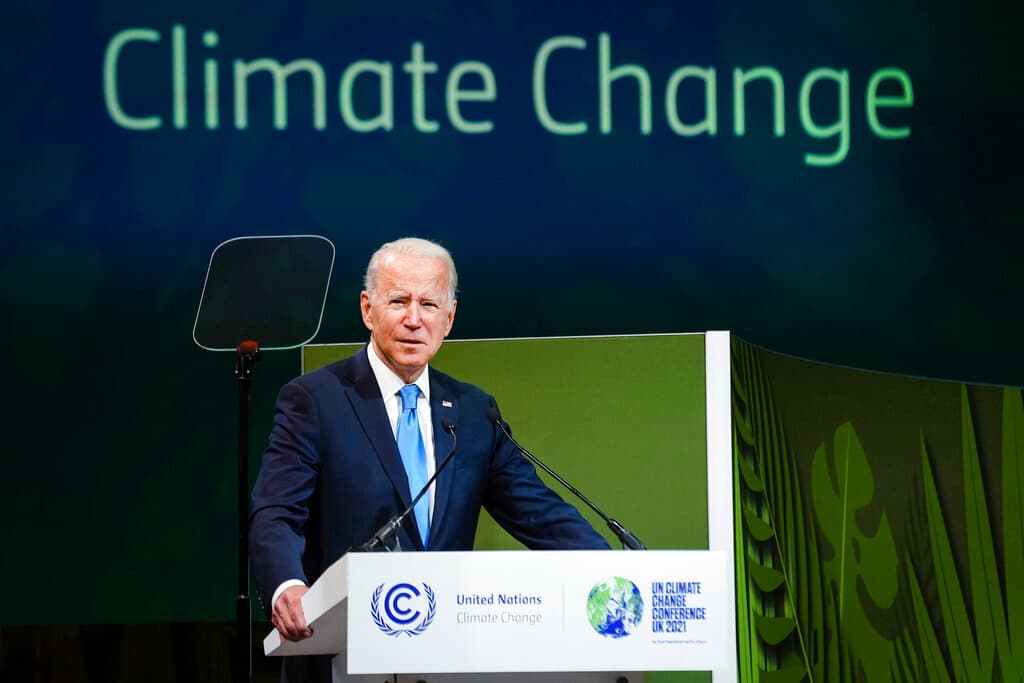Climate-Focused Liberal Voters Split on How To React to Soaring Fossil Fuel Production Under Biden
The incoming president of the US Climate Action Network, Ife Kilimanjaro, tells the Sun that the groups she works with often ‘see Biden as the lesser of two evils.’

With American oil and gas production soaring to new highs under President Biden, climate-concerned voters are split on how to respond ahead of the 2024 election.
Last year, America reached a new all-time high in oil production, churning out 13.1 million barrels of crude oil and condensate products a day in August.
In December, American liquefied natural gas exports hit a monthly and annual high, with America exporting 8.6 million metric tons of LNG in December, surpassing Qatar and Australia to become the largest LNG exporter in 2023.
Combined with slumping demand, the increase in oil production has led organizations like GasBuddy to project gas prices will fall in 2024 to around $3.38 per gallon from $3.51 per gallon.
While falling gas prices and increased energy production have often been thought of as good news for presidents seeking re-election, for Mr. Biden the issue is causing a split among voters concerned with climate change and a transition to renewable energy.
While just 2 percent of voters consider climate change to be the no. 1 issue facing America, according to a December New York Times Siena College survey, a significant portion consider the issue important.
A Pew Research survey from early 2023 found that 37 percent of Americans consider addressing climate change a top priority, and another 34 percent say it’s important but not a top priority.
The US Climate Action Network is an organization that represents more than 190 member organizations focused on climate change. The incoming president of the network, Ife Kilimanjaro, told the Sun that these organizations and their members are split on how to respond to the soaring production under Mr. Biden, with some rallying behind him in the hopes of gaining more influence and others resisting the move toward increased fossil fuel production.
“They see Biden as the lesser of two evils, but they are trying to push him to a higher standard,” Ms. Kilimanjaro said of the first group of members. “They’re trying to push him to stop drilling and to commit to putting new resources into renewables.”
Ms. Kilimanjaro added that these activists are working to “get the word out about the resources he’s been moving through the IRA” and “skilling up” activists to work in and around state and local elections.
“A sizable portion of our members are trying to work with the Biden administration in those ways,” she said.
Ms. Kilimanjaro also described a second group of voters and climate-focused groups who maintain a more confrontational stance with the Biden administration over its climate policy.
These organizations are more likely to advocate for communities that struggle with the material consequences of oil, natural gas, and coal production and processing — like cancers and low air quality — alongside a broader mission to curb the effects of climate change.
Ms. Kilimanjaro said these groups are more likely to say, “We need to not play games and slow the transition to renewables,” and are more likely to focus on issues like pushing for programs to help energy employees learn new skills to work in renewables.
“What shows up in our membership is what is reflective of the broader American population, which is that there are differences in views,” Ms. Kilimanjaro said.
What effect the boom in fossil fuel production under Mr. Biden has on climate-centric voters’ likelihood to turn out to vote is unclear. Yet according to the Environmental Voter Project’s Battleground State Poll, low-propensity voters are more likely to prioritize climate change than high-propensity voters.
According to the EVP survey, 7 percent of unlikely voters and 5 percent of likely voters consider climate the most important factor when choosing a candidate to vote for across four swing states — Arizona, Georgia, Nevada, and Pennsylvania.
The difference between these groups was most pronounced in Nevada, where climate was the top priority for 10 percent of unlikely voters and 5 percent of likely voters. In Pennsylvania, it was the top priority for just 3 percent of likely voters and 7 percent of unlikely voters.
This suggests that some climate-focused voters, who are already unlikely to vote, could be even more likely to stay home on Election Day.
What could be more problematic for Mr. Biden is that 53 percent of Democrats surveyed across the four swing states said they either probably or definitely would not support a “Democratic politician who supported increasing US use of fossil fuels, like oil, gas, and coal.”
While this number could shift in the context of a presidential election, for which Mr. Biden and President Trump appear poised to be the nominees of their respective parties, a perception of Mr. Biden as being pro-fossil fuel could chip away at his winning 2020 coalition.

